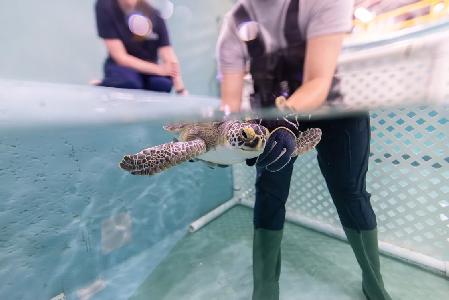A 1:1 replica of Han Solo frozen in carbonite — designed to match the version that appeared in “The Empire Strikes Back” and “Return of the Jedi” — is heading on a long journey. It’s not going nearly as far as Tatooine, but it will still mark a new home far, far away from Baltimore.
The Baltimore Node is in the midst of relocating to a new home of its own. The makerspace is moving just a few blocks to 2106 Lovegrove St., but it will have to give up one of its favorite decorations.
The replica was made by Todd Blatt, a Baltimore Node member and 3D-printing specialist who has found a big audience for Star Wars goods.
Reflecting the variety available at the Node, Blatt used a host of maker skills to create the replica, from laser cutting to Bondo sculpting.
First, however, he had to figure out how to build it.
In the movies themselves, there aren’t very many shots of the frozen figure, and only two props are in existence in the Lucasfilm archives.
Blatt was buoyed early on after finding that he didn’t have to recreate the images of a trapped Harrison Ford. In 1996, a company called Illusive Concepts was licensed by the Star Wars empire to produce replicas. Blatt was able to track down the body parts in rubber form, and received them in a rubber blob. Much assembly was still required, which is where the Bondo came in.
But that still left the vertical side panels, which in many ways are where the smallest details exist.
“You get certain pictures and you’re trying to figure out spacing of things and how big things are, and you never get a straight-on shot and exact measurements of things,” Blatt said.
Those also happen to be the details that Star Wars geeks obsess over.
“You could build the whole thing in a day if you wanted. But to get it perfect and get all the details, that’s a whole other level,” he said.
Blatt was able to find dimensions, and recreate some of the parts using 3D scans and AutoCAD. But the power to recreate things digitally is insignificant next to the power of 1970s prop makers who were just using found objects that happened to be lying around the studio.
Those studios aren’t much different from makerspaces like the Node, with lots of stuff lying around that gets turned into something else. Prop makers often don’t even remember what they used. In the case of Star Wars, it just so happened that what is later seen on the screen became a cultural touchstone.
It took until November 2011 for internet sleuths to find what was used to make the parts of the side panel. Turned out, it was a turn signal panel from a Volvo 343. The car was only made from 1977-1979, and only made in Europe (since the Star Wars prop team was based in the U.K.).
Other parts were from a record player and a camera viewfinder.
Using his own powers, Blatt was able to track down a Volvo 343 turn signal indicator, and made a mold to reproduce it. In addition to what he needed for the replica, he’s been making more for others who want a piece of the carbonite.
The other side features panels with LED lights, which uses code programmed through an Arduino to make the lights blink in accurate pattern. Blatt wrote the code on the bottom panel, which has eight LED lights, using an ATtiny.
While Blatt has done his best, he realizes that the project can never be a perfect replica.
“The level of detail never ends,” he said. “You can just keep going.”
Besides, focusing too much on the endpoint would overshadow the skills he picked up along the way.
“There’s tons of different things to learn,” he said. “It’s not always about the end product. It’s about the journey.”
Even though the Node’s 1:1 replica was shipped off, 3D printing makes sure that it won’t be a solo act.
Join the conversation!
Find news, events, jobs and people who share your interests on Technical.ly's open community Slack

Baltimore daily roundup: Medtech made in Baltimore; Sen. Sanders visits Morgan State; Humane Ai review debate

Baltimore daily roundup: The city's new esports lab; a conference in Wilmington; GBC reports $4B of economic activity

Baltimore daily roundup: Find your next coworking space; sea turtle legislation; Dali raided and sued




